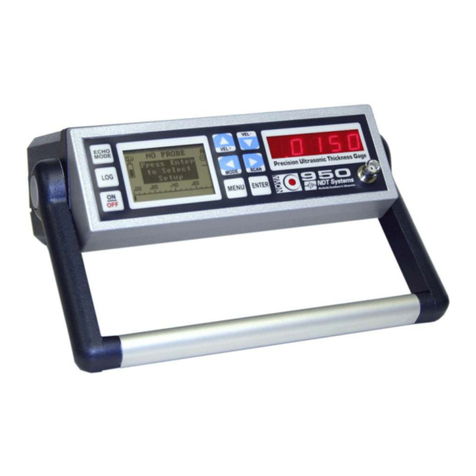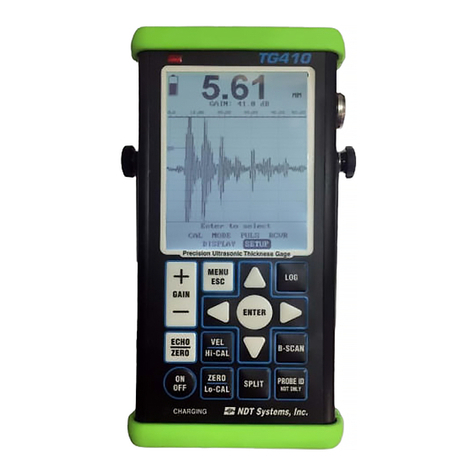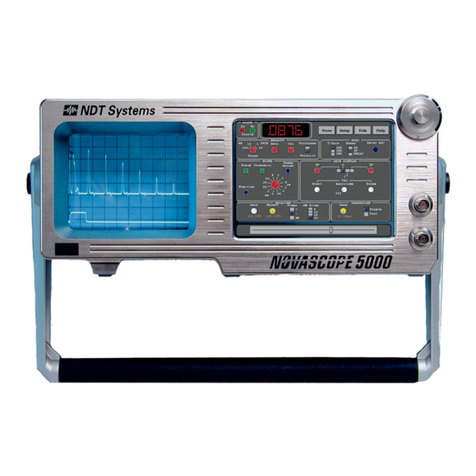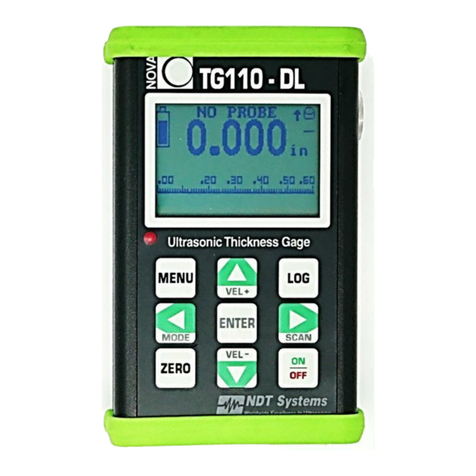
Nova Eclipse TG930 - Users Manual
14
to surface). Thickness readings should not be considered reliable if the
Coupling Indicator intermittently blinks, or flickers.
4.3 Basic Menu-Selections and Controls
The numerous features that set the NOVA 930 apart from other handheld
thickness gages, and make it so easy to operate, are readily accessed
through intuitive Menus and Sub-Menus. Not all features will be used for
some applications. However, there are many unique User-selectable
features that can be accessed for difficult applications.
MAIN MENU
The Main Menu can be accessed at any time the
NOVA TG930 is powered on by pressing the
MENU Touch Command button. To exit any Menu
or Sub-Menu, press MENU, and the display will
revert to the last-displayed Menu, if in a Sub-Menu,
or to the Measurement display, if in the Main
Menu.
Main Menu Items are:
When the Main Menu is accessed, the first item, DISPLAY, is highlighted.
To scroll to the other items, use the Down and Up ARROW keys.
DISPLAY MENU: Press MENU to display the
Main Menu. By default, DISPLAY is highlighted.
Press the ENTER key. There are four selections
listed: Adjust Scale, Backlite, Contrast, and
Units. To select any of them, use the Down
ARROW key to sequentially highlight them.
Adjust Scale Sub-Menu (Scan Bar): In the
DISPLAY Menu, with Adjust Scale highlighted,
press ENTER. The Measurement Display will
open, as shown:
The objective is to set the range of expected
thicknesses in order to set up the Scan Bar and its
accompanying scale. Use of the Scan Bar is optional. It provides an
analog-like visual cue of acquired digital thickness readings. If it is desired
to use the Scan Bar, its scale can be set by establishing Start and Stop
Nova Eclipse TG930 - Users Manual
15
limits. It can start and end at any values within the NOVA TG930
specifications. Setting Start at a thickness somewhat below the minimum
expected thickness, and Stop at a somewhat greater thickness (say,
approximately 10%), than the maximum expected, will produce optimum
visual enhancement. For example, if the thickness of the test object is
expected to range between 0.050 and 0.100 inch (1.27 and 2.54mm), a good
Start point might be approximately 0.045 inch (1.14 mm) and the Stop point
at approximately 0.110 inch (2.80 mm). This range will produce the greatest
visual motion within the range of expected thickness. On the other hand,
under the example above, if the scale is set to Start and Stop at 0.000 and
2.500 inches (0.00 and 63.50 mm), the range of motion between the
minimum and maximum expected thicknesses would be a very small
proportion of the total scale.
From the example above, where the approximate thickness range is
expected to be from 0.050 and 0.100 inch (1.27 and 2.54mm), set the Stop
point first. With the Measurement Display open, and with Start highlighted,
as shown in the Figure above, use the Down ARROW to highlight Stop. If
the Stop value displayed is greater than the desired Stop point of 0.110 inch
(2.80 mm), press and hold the Left ARROW key. The Stop value will rapidly
scroll downward. At a Stop value approaching 0.110 inch (2.80 mm),
release the Left ARROW key, and toggle it until the desired value is
obtained. If the Stop value is less than that desired, use the Right ARROW
key to scroll/toggle the displayed value. To set the Start point at 0.045 inch
(1.14 mm), repeat the above procedure.
Finally, press the MENU button three times to back through the Adjust
Scale and DISPLAY Sub-Menus and return to the Measurement Display.
Observe that the Scan Bar scale ranges between the desired Start and Stop
values. Measurement readings between Start and Stop will produce the
analog view of the Scan Bar, and both the display reading and the Scan Bar
will remain displayed until the next valid reading is obtained.
If it is chosen not to use the Scan Bar, Adjust Scale settings can be set to
values below the Start value. Measurements within the expected range will
produce an off-scale Scan Bar. Regardless of the settings of the Scan Bar
scale, thickness readings and the accuracy of readings are unaffected.
Backlite Sub-Menu: In the DISPLAY Menu, toggle the Down ARROW to
highlight Backlite. Use the Right (or Left) ARROW to toggle through the
three selections, Auto, Off, and On. In the Auto mode the backlight will turn
on automatically when the transducer has valid coupling with the test object,































